Tesla Megapack energy storage could save the world? Let’s take a look at this exciting topic and see what all this energy storage is about. Don’t worry, we won’t leave you in the dark!
First of all, let us tell you the truth: this is a large-scale battery system designed for grid-grade energy storage. It is planned to play an important role in the transition to renewable energy by helping to stabilize power grids and store excess electricity. In simple terms, it’s like a giant rechargeable battery for the power grid.
How big is a Tesla Megapack
Large-scale energy storage has always been difficult. Electricity cannot be put in a container and kept for later, unlike food or water. Conventional batteries are not appropriate for grid-level storage due to their limited lifetime and capacity. Here’s where the Tesla Megapack enters the picture and provides an answer to this energy dilemma. These enormous devices, which use clever architecture and cutting-edge lithium-ion technology, can store energy when it’s abundant and release it when needed, balancing the fluctuations in the supply and demand for electricity. It’s similar to having a massive power bank that can power the whole grid and maintain lighting even in the absence of wind or sunshine.
Of course, now that I explain it like this, don’t think of the Tesla Megapack as an average AA battery. Each unit is about the size of a shipping container and can store up to 3 megawatt hours (MWh) of energy. This is enough to power hundreds of homes for several hours.
These huge batteries are often grouped to create even larger energy storage systems. For example, the Cheviré project in France is rumored to install multiple Megapacks to create a 200 MWh system capable of powering more than 170,000 homes for two hours.
What makes the Tesla Megapack special
The Tesla Megapack stands out for several reasons:
- Scalability: Megapacks can be easily combined to create systems of various sizes, from small installations to massive utility-scale projects.
- Quick deployment: These units are designed for fast installation. They come pre-assembled and pre-tested, reducing on-site work and speeding up project timelines.
- Integrated software: Tesla’s Autobidder system helps manage the Megapack, optimizing energy use and potentially increasing revenue for operators.
Tesla Megapack is being used in projects around the world. In France, construction has begun on the Cheviré project, which will be the country’s largest battery energy storage system when completed.
In California, another project is underway using Tesla Megapacks to create an 800 MWh storage system. This facility is being built on the site of an old steam plant. How ironic is that? We are moving to renewable energy.
Tesla has also signed a major contract with Intersect Power to provide more than 15 GWh of Megapacks. This agreement makes Intersect Power one of the largest buyers and operators of Megapacks worldwide.
Tesla currently produces Megapacks at its “Megafactory” in Lathrop, California. The company is working to increase production at this facility and has started building another Megafactory in Shanghai, China. Each of these factories aims to produce around 10,000 Megapacks per year when they reach full production capacity.
As more countries and companies commit to renewable energy targets, the need for efficient energy storage solutions like the Tesla Megapack is likely to increase. These systems play a crucial role in managing the intermittent nature of renewable energy sources such as solar and wind power.

The hot topic of battery safety
Tesla Megapacks have fierce opponents despite their formidable energy storage capabilities. Similar to their smaller counterparts, these enormous batteries are made of combustible materials that have the potential to catch fire in certain situations. A thermal runaway, or a cascading effect of heat and chemical reactions, might result from a Megapack breakdown in the worst situation. There might be explosions, poisonous vapors, and flames from this possible powder keg. Because of their immense size, these units carry a higher danger of escalating a minor incident into a major fire. When fighting such infernos, firefighters encounter particular difficulties since water is sometimes insufficient to put out these chemical flames. Despite Tesla’s implementation of several safety procedures, some towns that are considering large-scale energy storage installations are still concerned about the risk of battery conflagration.
Featured image credit: Tesla Megapack





